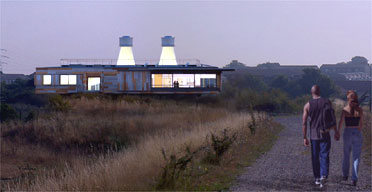Not strictly for the birds
Conservationists say a 1,600 acre nature reserve on the Rainham Marshes will complement sustainable housing in the Thames Gateway, writes Matt Weaver
You don't have to look far to see why the Thames Gateway has an image problem. Taking a trip east out of London involves going through a vast wasteland of scrap metal yards, landfill tips and disused factories. In between the electricity pylons and flyovers there is a high concentration of some of Britain's worst new housing.
This is not an attractive place to live, and yet the government plans to transform the area into a network of new "sustainable" settlement containing up to 120,000 new homes.
To anyone gazing out of a window of a train travelling through the Thames Gateway such an ambition seems absurdly optimistic.
But perceptions about the area rapidly change when you get to Rainham Marshes on the London Essex border. Suddenly the landscape opens up as wasteland is replaced by water meadows beside the Thames.

It seems an unlikely place for a spot of bird watching, but on the edge of a sink estate in Purfleet the marshes are being transformed into a 1,600 acre nature reserve by the Royal Society for the Protection of Birds.
A strikingly designed eco-friendly environment and education centre is nearing completion on the site. The new building and the nature reserve are crucial to changing the battered reputation of the Thames Gateway, according to those behind the project.
But there are worries that the area's regeneration won't go much further than this promising beginning. It's feared that government penny pinching and a new focus further up river at the site for the 2012 Olympics are wrecking the ambitious plans for the gateway.
For now the government agency that helped fund the scheme is remaining positive. Will McKee, chairman of the Thurrock Thames Gateway Development Corporation, says new green spaces like Rainham are crucial to the reputation of the area.
"There has been neglect in the past which has created an image that is partly true. People around here think their neighbourhood has been London's dumping ground. They are looking to have their landscape back - projects like this are the beginning of that process."
McKee and other Thames Gateway dignitaries have come to Rainham to celebrate the visitor centre's topping out - a construction stage that signals the building is nearly finished.
When the plans were first unveiled two years ago by the architects Van Heyningen and Haward, the Guardian's architecture critic Jonathan Glancey said the building promised to "combine common sense and magic".
Those qualities are now becoming evident for all to see. It looks set to be carbon neutral by generating enough power through solar panels, heat extracted from the ground and a planned wind turbine to offset the emissions involved in its use.
Perched on the edge of the Thames's flood wall, the building is entered by two drawbridges, which will be raised at night to deter vandals. But it is a welcoming edifice as well as a tough one, with a generous balcony overlooking the river on one side and a bird viewing area overlooking the marsh on the other.
The weatherboard cladding is also cheerfully coloured, in pink, grey and orange. It's pretty garish for a nature reserve and senior figures at the RSPB aren't quite sure about it - Graham Wynne, the RSPB chief executive, diplomatically says the "colours will grow on me".
But he is chuffed to bits with the development as a whole. "We are hoping this will stand as an exemplar for the whole gateway. Not just for the green infrastructure but for the quality of the built environment. The area desperately needs good quality, low energy buildings."
Such qualities come at a price, as Henry Binns, one of the architects, points out. "Building green is not cheap," he says.
Nor is high quality architecture. There is a fear that in the rush to build in the Thames Gateway, design and energy efficiency will be sacrificed by developers keen to maximise profits.
The government insists the gateway will be different, but there is little evidence of that from estates built here in the last 20 years. A study by the Institute of Public Policy Research found that people are likely to shun the area, fearing the new houses will be identikit boxes in developments devoid of a sense of community.
Wynne, who has bought in nearby Upminster, argues that high quality green spaces will be important for attracting investment in good quality buildings. "I think south Essex has a rougher reputation than it deserves, but the truth is that if you think you can attract inward investment without a high quality environment you are fooling yourself.
"In theory the government accepts that, because there is bags of rhetoric to that effect, but it is far from consistent in terms of turning that into practice."
The government has identified four growth areas, including the Thames Gateway, where it plans to concentrate new housing over the next 20 years.
In the three other areas - Ashford in Kent, Milton Keynes, and the M11 corridor in Essex - ministers have pledged to invest 10% of infrastructure funding on green projects like parks and nature reserves.
But in the Thames Gateway no such commitment has been made.
This worries Wynne. "We don't want to be churlish because we have had genuinely good public sector support for this project, but it's not clear that public support is going to be there for the long term to regenerate the green environment.
"Without appropriate funding for green space projects, regeneration east of London will be dogged by the image of a low quality environment that will restrict progress for years to come."
There is also a fear that some of the money earmarked for the gateway will now go towards the Olympics. But McKee argues that attention should not be diverted by the games: "Everybody knows the Olympics are on the agenda, so there has had to be some change of focus, but it would be wrong to think that means less focus on the gateway."
For Wynne and the RSPB the Rainham marshes are also valuable in their own right as a nature conservation project.
This is medieval grazing land - an increasingly rare habitat in Britain. The land was only saved from the ravages of development by a strange quirk of fate. It had been used by the Ministry of Defence as a firing range, which left it largely untouched apart from the odd leftover shell.
The RSPB cleared the site and raised the water level to attract endangered wading birds such as redshank and lapwing. Now 150 separate species are recorded here each year, including the iconic avocet, the bird that features on the RSPB's logo and was once nearly extinct in Britain.
Wynne is proud of what has already been achieved. "If you look out over the marsh we've got 1,600 acres straddling the London Essex border which is of genuinely high conservation value. It's hard to think of a capital city in the western world where you can access green space on this scale, so close. We are talking about tens of thousands of wild fowl and waders that depend on it."
As if to underline his point a little egret, a rarity in Britain only 10 years ago, flops into one of the dykes.
Rainham also provides the RSPB with an opportunity to reach a new and different audience. It has tended to be associated with people who are white, middle aged and middle class. The demographics of this area are very different, as Wynne explains.
"We've spent our 117 years concentrating on nature conservation in the depths of the countryside. That has meant that if you want to see nature you have to travel to it. Here we have the opportunity to bring wildlife closer to where people live. That means we can enthuse a lot more people about wildlife."
The project may also enthuse more people about the Thames Gateway.
guardian.co.uk, 15th Jun, 2005
